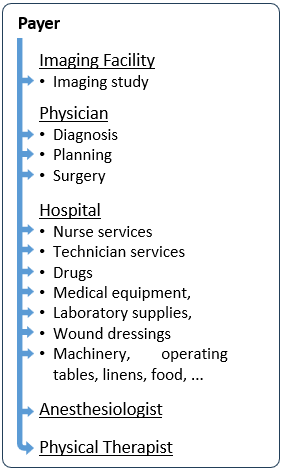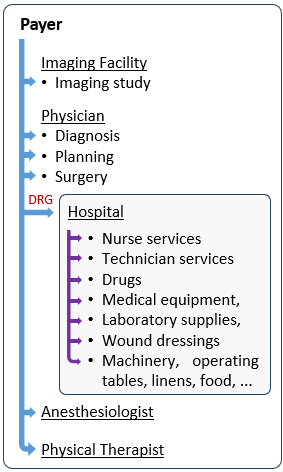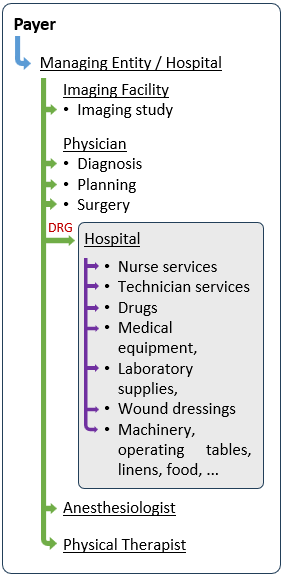Introduction – Reimbursement Decision Makers
In the intricate world of medical device commercialization, one of the pivotal factors determining market success is the ability to secure reimbursement. Companies invest years and millions of Dollars in designing their product, in obtaining its regulatory clearance/approval, in developing appropriate clinical data and in making decisions regarding its price, but they often do so without considering who would eventually need to decide whether or not to pay for their product.
The entity which will make this decision might be a payer (sickness fund/health insurer), a hospital, a physician group or an accountable/integrated care organization (to name a few examples). When considering its reimbursement/funding decision, each of these entities may assign different values to different product features, a different “intended use” in the regulatory clearance/approval document, different clinical data points, and a different price structure, so working on a medical product without first identifying who your reimbursement decision maker is, is like preparing for the World Steak competition in order to offer a costly steak to a penniless vegetarian, or hiring a vegan chef to recommend a quinoa salad to a dedicated carnivore.
In this focused exploration, we delve into the critical role of identifying the relevant decision maker in order to facilitate the development of the right product, the appropriate wording on the product’s regulatory clearance/approval document, the required clinical data points and the most relevant pricing structure, all designed to meet the needs of the identified reimbursement decision maker.
Example 1 - The Payer is the Reimbursement Decision Maker
Under traditional Fee-for-Service reimbursement systems, when a patient needed surgery (e.g., knee replacement), the payer paid for each provided service – a service-centric reimbursement system. Thus, the payer paid the imaging facility for the CT scan, paid the physician for determining the patient’s diagnosis, planning the surgical procedure and performing it, paid the hospital for its associated services in facilitating the surgical procedure, paid the anesthesiologist and paid the physical therapist for the patient’s rehabilitation process post-surgery.
In order to pay for each of these separate services, the payer needed a way to separately indicate each service, and this was typically done with a dedicated code. This situation meant that if your company planned to develop a new imaging modality, a new physician diagnostic tool, a new wound dressing or a new rehab device, a new code had to be developed. In addition, the payer had to make a decision about the coverage of this new code; would it be paid for by the payer or not, making the payer the ultimate decision maker for the reimbursement of each and every medical service.
In the chart on the right, each of the little blue arrows indicates a separate service and a potential separate code, requiring a separate coverage decision by a payer.

Example 2 - Each Hospital is the Reimbursement Decision Maker
The need to specifically approve each and every discrete medical service by the payer became cumbersome and led to inefficiencies. This started to change in the 1980’s, with the introduction of Diagnosis-Related Groups (DRGs), first in the US and subsequently in Europe. DRGs changed the way hospitals are reimbursed and moved from a service-centric reimbursement system to a provider-centric reimbursement system.
Under the DRG method, each hospitalized patient is assigned to a single DRG, under which cases with similar clinical conditions and resource utilization patterns are grouped (e.g., total knee replacement). Each DRG is assigned with a pre-determined, single payment rate, that is paid to the hospital regardless of the actual number of discrete medical services provided to the individual patient by the hospital. It does not matter how many lab tests, wound dressings, drugs or nurses are assigned by the hospital for the treatment of a specific patient. The hospital receives the same pre-determined single lump-sum for every patient undergoing total knee replacement. The hospital also decides how to allocate this single lump-sum to finance required lab tests, medical devices, drugs and nurse time.
This not only shifts the financial risk associated with the treatment of a patient under a specific DRG from the payer to the hospital, but also turns the hospital to your main decision maker, in case your company develops a component that falls under a specific DRG.
As can be seen in the chart on the right, instead of multiple arrows for each discrete component within the hospital, the payer now pays the hospital a single DRG rate and the hospital becomes the decision maker, who decides which devices to purchase, how to use them, and negotiates their prices. In such case, the payer is indifferent to the type, number or price paid by the hospital for your medical device.

Example 3 – The Accountable/Integrated/Bundled Care Organization is the Reimbursement Decision Maker
The development of accountable/integrated/bundled care organizations, which is applied in both the US and Europe, signifies a further shift from a provider-centric reimbursement system to a patient-centric one. Instead of paying each provider, the payer contracts with a managing entity (which may also be one of the participating hospitals), to manage the overall care provided by all network providers (imaging centers, physicians, hospitals, rehab facilities) to beneficiaries who voluntarily agree to receive care under this arrangement.
The accountable/integrated/bundled care agreement may cover a specific procedure (e.g., total knee replacement), a specific disease (Diabetes) or all care provided to a participating beneficiary over the course of a certain time period (e.g., a year). The payer typically pays a single lump-sum per participating beneficiary and the managing entity negotiates the allocation of funds with each of the participating providers. In this case, the payer is not involved in the decision-making process concerning utilized medical devices. The managing entity becomes your main decision maker.
As can be seen in the chart on the right, instead of multiple arrows for each provider, the payer now pays the managing entity a single lump-sum per participating beneficiary, and this managing entity becomes the decision maker who decides which devices to purchase for its network providers and negotiates their prices.

Real Life Examples
As mentioned above, a physician, a hospital, an Accountable/Integrated/Bundled Care Organization or a payer may pose different requirements concerning product features, regulatory approval or pricing, before deciding on the reimbursement of a new medical device.
As an example, one of our clients developed a product that showed superior clinical results, compared with any utilized alternatives, at a much lower price. Physicians and hospitals were happy to quickly adopt it, but since the number of sensors it featured was different than existing competitors’ products, payers required additional clinical data that substantially prolonged time to market and required additional funding. Focusing on hospitals as the company’s decision makers, enabled a much quicker commercialization.
Another client commercialized an innovative product, that was proved to improve patient outcomes, but the wording used on its regulatory approval was found inadequate with respect to traditional payers’ coverage requirements. However, this was not a problem from the perspective of accountable/integrated/bundled care organizations.
The point that we’re trying to make is that developing a product with the wrong decision maker in mind, may lead the company to make wrong decisions regarding the features that should be developed, the regulatory strategy it should pursue, the clinical data it should strive to develop, and the pricing strategy it should adopt. These mistakes may be difficult to correct if discovered at a late stage.
Proposed Solution
To identify the correct decision maker for your product, we recommend performing Activity 1 in our reimbursement process, in which we lay out money flows and financial incentives associated with the use of your specific product, indicate specific reimbursement mechanisms (such as codes, coverage policies and payment rates) that may apply to your product, and as a result determine the most appropriate decision maker for your product.
Knowing this in advance, before finalizing your product design, deciding upon your regulatory strategy, designing clinical studies or setting a pricing strategy, will help you efficiently progress towards a smooth market entry and reimbursement success.
Once we have that data, and only then, we can proceed to our Activity 2, where we develop the product’s value story (from the perspective of the identified decision maker), devise an applicable economic model, review your clinical development plan (to make sure it addresses your decision maker’s requirements) and engage directly with the identified decision makers, to obtain their validation for all of the above, in advance.
Next Steps
To explore Activity 1 and Activity 2, click on the box on the right.

